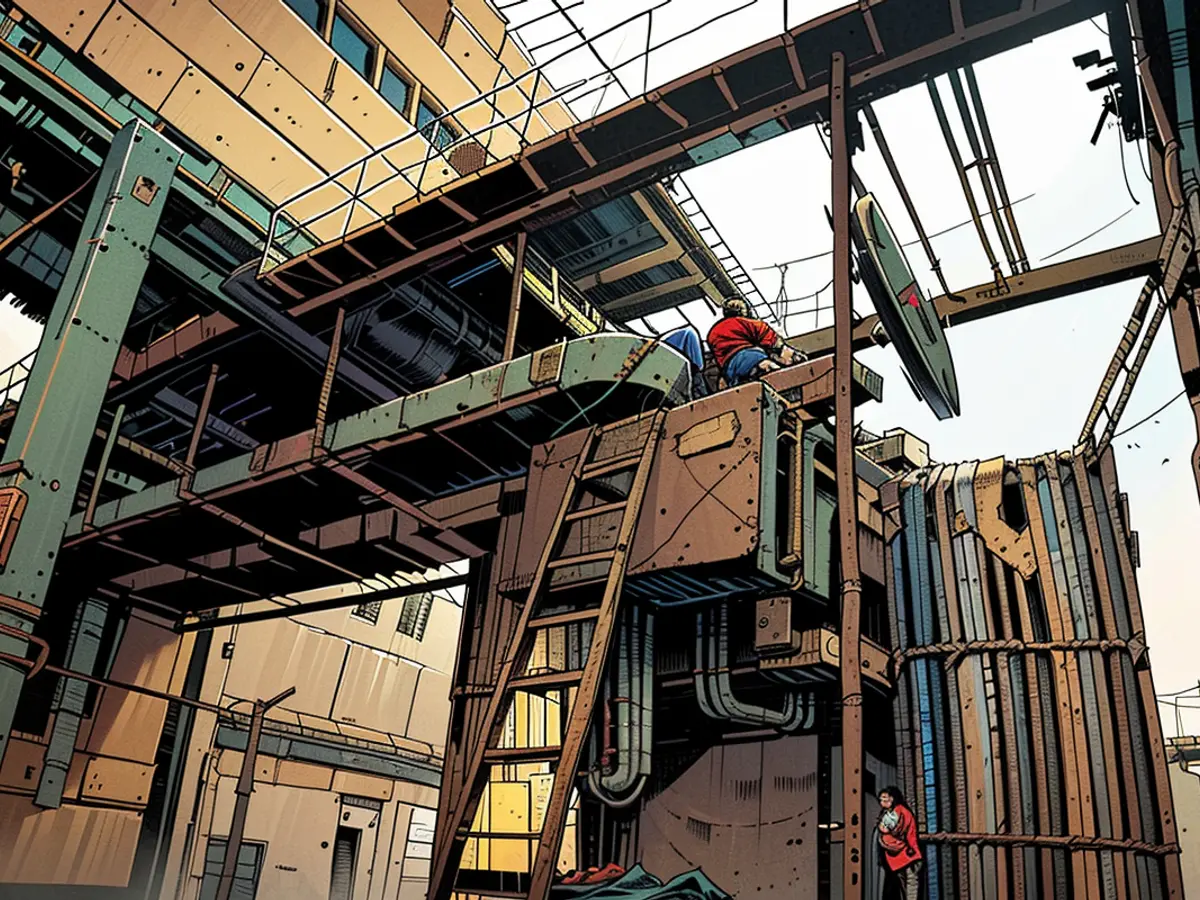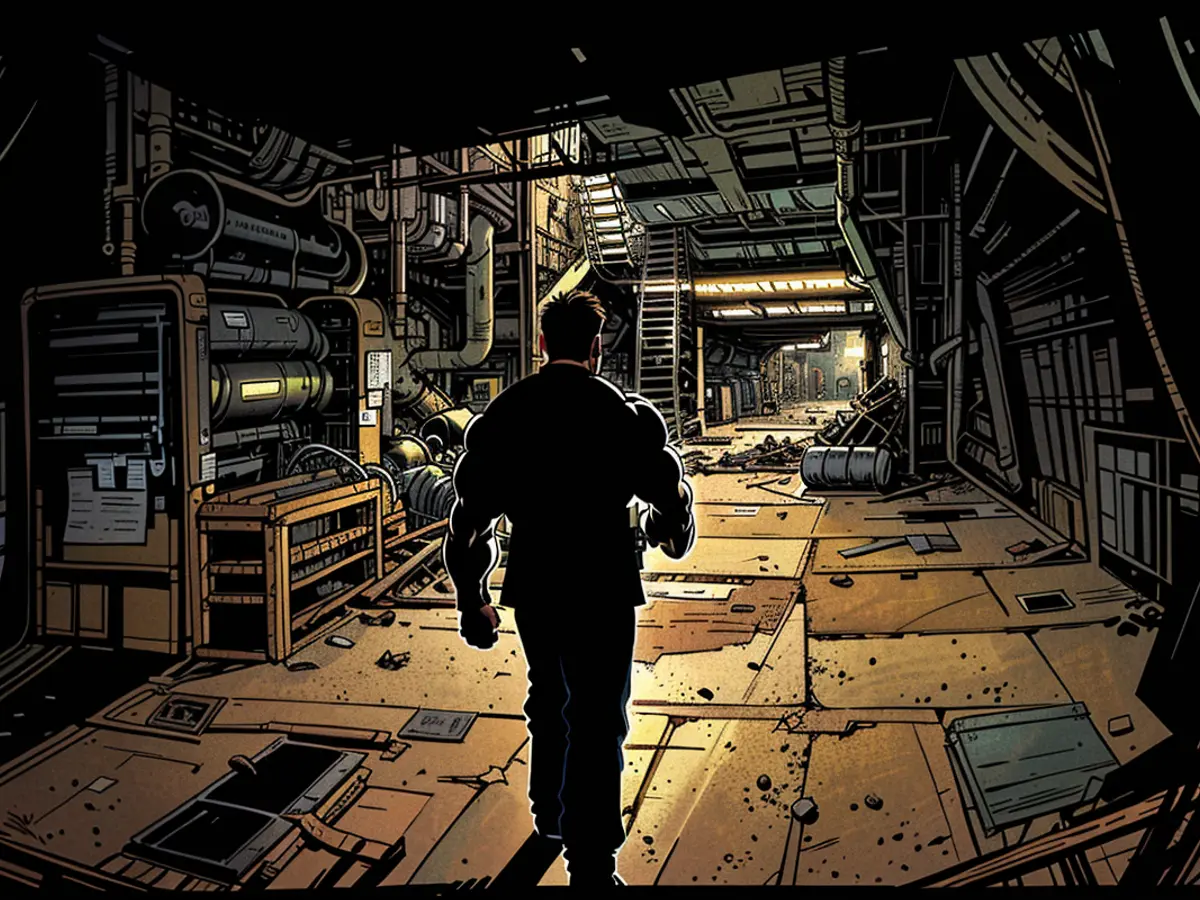Ukraine assembles "Frankenstein-style" equipment for winter use.
Russia's relentless strikes on Ukraine's power plants have left half of its electricity generation capacity in ruins. The looming winter could be disastrous without quick action, according to Dmytro Sakharuk of Ukrainian energy company DTEK, in an interview with ntv.de. Apart from repairing the damaged power plants, Sakharuk suggests the need for additional air defense and increased electricity imports from neighboring countries.
In the long run, Ukraine's power supply needs a more distributed energy source, and Sakharuk advocates for an increase in renewable energy. He notes that although wind turbines and solar panels can also be targeted, the resources needed for widespread attacks make it less appealing, with repairs being quicker and easier.
ntv.de: President Zelenskyy spoke at a reconstruction conference in Berlin on Tuesday, stating that Russian missile and drone attacks have ravaged half of Ukraine's electricity production. How has Dmytro's company been impacted?
Dmytro Sakharuk: Before the recent series of attacks, which started on March 22 of this year, we operated six power plants.
Coal or gas?
Coal. They had previously been attacked during October 2022 to February 2023, but we were able to repair them. This year, there were six attacks on our power plants - two in March, two in April, one in May, and one in June. The combined capacity of these six power plants was 5 Gigawatts. Currently, we only have 500 Megawatts available for electricity production. We're working diligently to restore at least half of the damage by the start of the heating season.
By October?
The timeline depends. Historically, the heating season in Ukraine begins on October 15. Last year, due to the unusually warm weather, the start date was delayed until November 1. To repair half the damage, we'll need 350 to 400 million dollars, primarily for the procurement of transformers, turbines, and generators. The issue is that companies don't typically hold such items in stock, and such equipment is custom-made for each specific plant, leading to long lead times and requiring a down payment.
Are repairs possible?
There's potential for a short-term solution this year. We may be able to source material from power plants in countries like Poland, the Czech Republic, Bulgaria, Romania, and Greece, built during the Soviet era. Alongside the Ukrainian Energy Ministry and Ukrainian energy companies, we're visiting these plants to assess what can be utilized in Ukraine. Many of them are being decommissioned due to environmental regulations. We've found some suitable items but need more, and they are essential. However, they require repairs, loading onto trucks, and transportation to Ukraine. The material may not always fit perfectly, leading to some power plant blocks becoming Frankenstein units.
Do you have enough engineers and personnel to repair the damaged power lines and installations?
Yes, DTEK employs 50,000 workers across various sectors. For instance, miners who are currently helping with installation and power plant repairs. However, we face a shortage of specialists to adapt the material from old power plants in neighboring countries. The extent of the damage means we don't have enough engineers for this task. Additionally, we lack staff to dismantle and transport the equipment where it's needed. Currently, around 5000 of our workers are serving in the military. 289 have been killed, 875 injured, 66 are missing, and we have 12 workers in captivity. Some workers have also perished on the job - four were killed, and 65 were injured. This comprises the heavy toll we pay for managing power plants. We need workers to monitor the blocks - even when alarms go off. We initially reduce the number of colleagues and implement added safety measures in control rooms, with team members donning protective vests and helmets. Despite these measures, the job remains extremely dangerous, with our people serving like soldiers in a frontline trench.
What contribution will the Frankenstein blocks offer?
They will likely only meet 15-20% of the total demand. Consequently, additional material must be procured, as it's not feasible to rebuild some locations using old materials - for example, in control rooms. We are in dire need of funds - the financial requirement is high, and our company's turnover is low. During the first wave, we invested 126 million dollars in repairing ten units. All ten units now require repair. We hope for international aid. The Ukrainian government could provide affordable loans, and international organizations like the European Bank for Reconstruction and Development or the European Investment Bank might provide loans for equipment procurement and project financing. The US Aid agency has already granted 46 million dollars for equipment procurement, as well as 26 million dollars from the European Energy Security Support Fund. However, the overall shortfall remains significant - we need 350 to 400 million dollars before the heating season begins. Additionally, there are only around 140 days left until then.
Is there a notable difference between the post-March attacks and the first attack wave in the winter of 2022/2023?
During the first wave, we had more air defense. In this spring, the Russians took advantage of prolonged delays in ammunition supplies from our American and European partners, waiting until Ukraine was nearly out of air defense resources. Russian timing and our defensive capabilities are the primary factors here.
Right now, we're making it clear in every negotiation that it doesn't make sense to have money, equipment, and people ready to work if the Russians launch another air attack on our power plants, whether it's in a month, a week, or even a day, causing them to be destroyed again.

It's confusing as to why the Russians decided to strike the energy infrastructure in March.
But it makes perfect sense when you think about it. From December to February, they bombarded us with cheap Shaheen drones to deplete our defenses. Once they realized our reserves were almost depleted, they knew the time had come to send rockets. It's not enough if we restore our electricity generation capacity; we must also protect it. But there's another thing we need.
What's the third thing, you ask?
We need to increase our electricity imports from Europe. As of March 16, 2022, Ukraine is connected to the European power grid. The connection capacity is currently 1.7 Gigawatts, which comes from Poland, Slovakia, Hungary, Romania, and Moldova. Technically speaking, the capacity is actually 3.5 Gigawatts. The limit of 1.7 Gigawatts was a decision made by ENTSO, the European Network of Transmission System Operators. These engineers decide how much electricity can be transferred from one country to another within the European network. They usually take a very cautious approach. When our energy systems were synchronized, the ENTSO engineers said it was impossible, and we had to wait two years. thanks to the European Commission's political pressure, it happened in March, and it's working seamlessly. We probably won't reach 3.5 Gigawatts, but 2.2 or 2.5 are definitely possible. From a technical standpoint, everything is ready.
So, how much electricity do we need?
We have a power deficit of 2 Gigawatts in Ukraine. In winter, it will reach 4 Gigawatts, as many people use electricity for heating. An increase in electricity imports of 0.5 or 0.7 Gigawatts could replace two or three damaged blocks. This could significantly reduce the number of power outages.
Okay, how often must the power be cut off?
The state transmission system operator, Ukrenergo, sets limits for the regional utilities. The regional utilities disconnect customers according to schedules. For example, DTEK has implemented a rolling schedule in Kiev: Residents have four hours without power, then five hours with power - and so on. In winter, when the energy deficit increases, the power outage periods will be significantly longer: seven hours without power, two hours with power. People will be without power in their homes for up to 20 hours. That's a big problem. 500 or 700 Megawatts from our neighbors could significantly ease our situation.
What about a decentralized energy system?
Yes, with turbines and generators. Ukraine should bring in everything possible and install important infrastructure such as water-, sewage-, and heating systems. None of these systems work without electricity. If there is no electricity, people have no electricity, but possibly also no heat, no water, and no sewage. Then apartments become uninhabitable. As the president said on Tuesday, we have lost 9 Gigawatts. The possibility of replacing even parts of that without decentralizing our energy system is limited. The decentralization of our energy system will take two to three years, so we need to start now. It's not just about procuring turbines and generators, but also about integrating them into the grid. That takes time. Nevertheless, it is the fastest and most cost-effective solution.
What are those generators like?
The small generators we have in mind would be gas turbines with a capacity of 25 Megawatts, or generators that operate like a ship's engine on diesel or gasoline. They could produce up to 18 Megawatts. With enough generators, we could maintain the vital infrastructure that is needed in winter, so that people can stay in their homes.
What role do renewable energy systems play in this concept?
That's the next step in the development of the Ukrainian energy system. The share of renewable energies in Ukraine has risen to 11 percent. Before the war, our company had built 1.2 Gigawatts of solar and wind power plants. Sadly, 500 Megawatts of that are in the occupied part of Ukraine, in the southern part, in the region of Zaporizhzhia, which is controlled by the Russians. We still have two large solar power plants with a capacity of 200 Megawatts. During the war, we additionally built 114 Megawatts of wind power. Cities like Odessa and Mykolajiw can be supplied with electricity from our wind farms in the south, if the substations in the region are destroyed.
It's essential to build up renewable energies because they are more resilient: Of course, wind turbines and solar panels can also be attacked, but the Russians would have to invest much more resources for that, because the plants are distributed over a large area. And they're definitely easier and faster to repair.
Interview with Dmytro Sakharuk by Hubertus Volmer and Maryna Bratchyk

Read also:
- In response to the ongoing attack on Ukraine's power infrastructure, President Volodymyr Zelenskyy has called for increased international aid to help Ukraine boost its electricity imports from neighboring countries, such as Poland and Romania.
- Dmytro Sakharuk, Managing Director of DTEK, the largest private energy company in Ukraine, has highlighted the need to increase the use of renewable energies in the country's power supply to make it more resilient against terrorism and attacks like those currently being experienced.
- As part of Ukraine's efforts to improve its power supply during the winter months, interviews with energy experts like Dmytro Sakharuk have suggested a renewed focus on air defense and securing neighboring countries' support, including electricity imports, to help mitigate the impact of Russian strikes on Ukraine's power plants.








